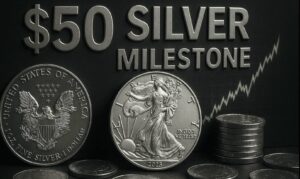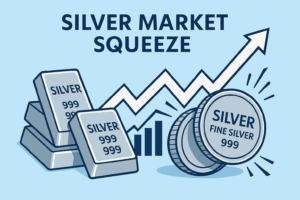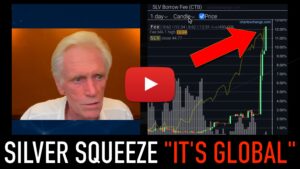Written by: The MacroButler
The markets have dubbed 2025 not a Jubilee, but a fog—thick with the unknown. Investors fumble through it, sensing chaos, yet naming it uncertainty without grasping its nature. So let’ dissect the case of the Jubilee Year of Uncertainty. Frank Knight, the economist-sleuth of the early 20th century, cracked the code in 1921. In Risk, Uncertainty, and Profit, he drew a decisive line: risk is measurable; uncertainty is not. Risk has odds. Uncertainty has shadows.
“Uncertainty,” Knight wrote, “must be taken in a sense radically distinct from risk.” The former can’t be tamed by statistics. It defies calculation, resists models, and mocks forecasts. And it is this unknowable element—this Knightian uncertainty—that grants the entrepreneur his profit. Not for taking chances, but for navigating the incalculable. Others, like Keynes and Davidson, followed his trail, deepening the theory. But the essence remains: when the future cannot be plotted, profit arises from daring to act anyway. In 2025, with the fog thick and logic thin, it’s not risk we face—but uncertainty. And that makes all the difference.

This framework—Knight’s grand distinction between risk and uncertainty—is still hailed as foundational in economics and decision-making theory. Apparently, we must now build entire theories around things we can’t measure. As a trader, not an ivory tower academic, investors can take issue with this supposed “uncertainty.” Nothing is truly uncertain—unless you ignore about 5,000 years of human history. But that’s exactly what classical economists do. They dismiss ancient patterns as irrelevant or the data as “inconsistent.” Because, of course, if it doesn’t fit into their Excel spreadsheet, it can’t possibly exist. Add to that the utterly charming notion—first spun by Karl Marx and repackaged by Keynes—that the economy is a wild, random beast that governments must constantly tame. Yes, let’s put the most bloated, short-term obsessed institution in charge of managing “unpredictability.” What could go wrong?
Remember school? In economics class, they said the economy was random and required constant government steering. In physics, meanwhile, they insisted nothing is random. So, either Newton was wrong, or your econ teacher was blowing smoke. As a matter of fact, those who understand cycles know that it wasn’t Newton.
The truth is that the economists and politicians never bothered to study the cycle—they just assumed they could outsmart it. Now, the world gets to enjoy the consequences of that intellectual laziness.

Anyone who’s cracked open a real finance book—or better yet, survived a few rounds in the markets—tends to raise an eyebrow at classical economist theory. You know, the type cooked up in faculty lounges far from anything resembling a trading desk.
Take Arthur Burns, Fed Chairman when the Bretton Woods system fell apart. After watching the global monetary order collapse like a bad soufflé, he had a revelation: the business cycle exists… and it always wins. Revolutionary stuff, right?
Then came Paul Volcker—the man, the myth, the guy who brought interest rates to nosebleed levels just to break inflation’s kneecaps. He too concluded the business cycle was not just real but relentless. In fact, Volcker, probably the last Fed Chairman who actually understood economics (and owned a suit two sizes too big for comedic effect), famously said the cycle runs about every seven years. Which, of course, completely ruins the classical economist fantasy that recessions are optional and government interventions can sprinkle fairy dust on downturns. So yes, the business cycle exists. The only people who don’t believe in it are the ones still trying to publish another paper proving it doesn’t.
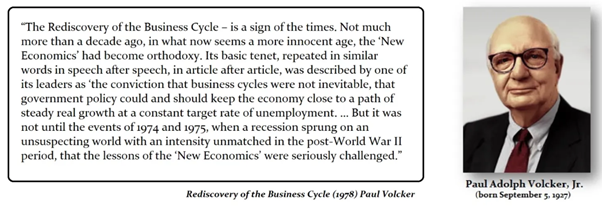
Ever since the Disruptor-in-Chief took the oath on January 20th, 2025, markets got the memo—loud and clear. That very day, the S&P-to-Gold ratio, one of the few indicators with a track record better than Wall Street’s spin doctors, broke below its 7-year moving average.
Translation? The economy isn’t heading for a soft landing—it’s bracing for impact. And no matter how many cheerful charts Wall Street tosses at their clients, the signal couldn’t be clearer: a darker chapter lies ahead.
S&P 500 to Gold ratio (blue line); S&P 500 to Gold Ratio 7-Year Moving Average (red line).

Savvy investors aren’t new to chaos, but policy uncertainty has now soared past even Trump’s first-term drama—impressive, really. The latest anxiety boost? A “reciprocal” tariff plan so vague it might’ve been drafted on a cocktail napkin. Retaliation? Plot twists? More tariffs? Absolutely. The Economic Policy Uncertainty Index (thank you, Baker, Bloom, and Davis) is flashing red, thanks to newspapers stuffed with words like “economy,” “deficit,” and “White House”—basically, a financial horror story in daily instalments.
US Economic Policy Uncertainty Index since 1984.
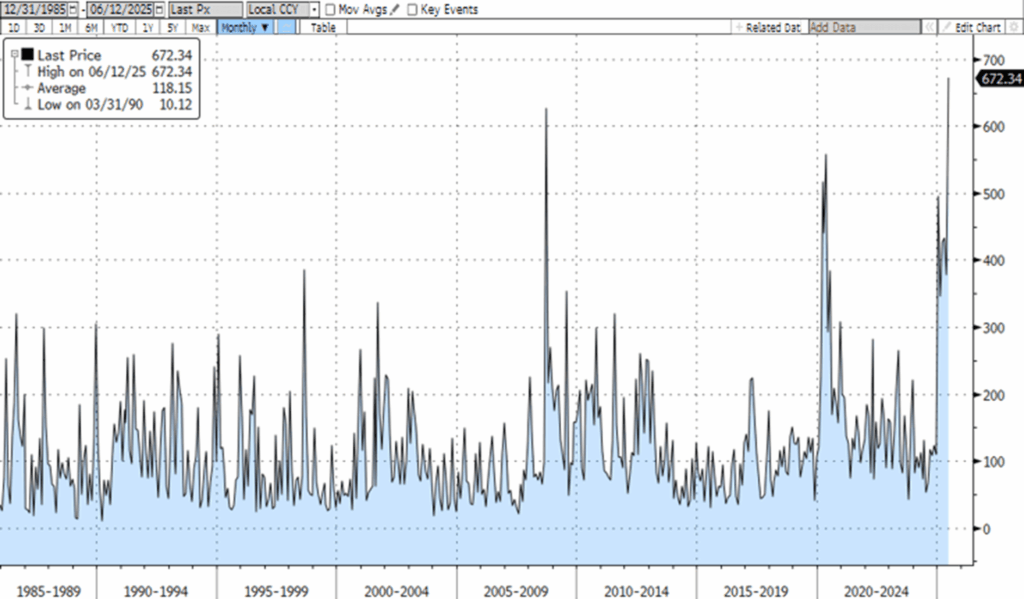
Thanks to the current US administration’s Olympic-level flip-flopping on tariffs, market uncertainty has gone from a simmer to a full boil. The verdict? Investors worldwide are starting to see the U.S. not as the beacon of rule-of-law finance—but as that unreliable friend who borrows your car and returns it with no gas and a dent. As trust in U.S. institutions wobbles, savvy investors are quietly exiting stage left. Why? Because they understand counterparty risk—and they know there’s one asset that doesn’t need anyone’s signature, bailout, or central bank reassurance: PHYSICAL GOLD.
US Economic Policy Uncertainty Index (blue line); Gold price in USD (red line).
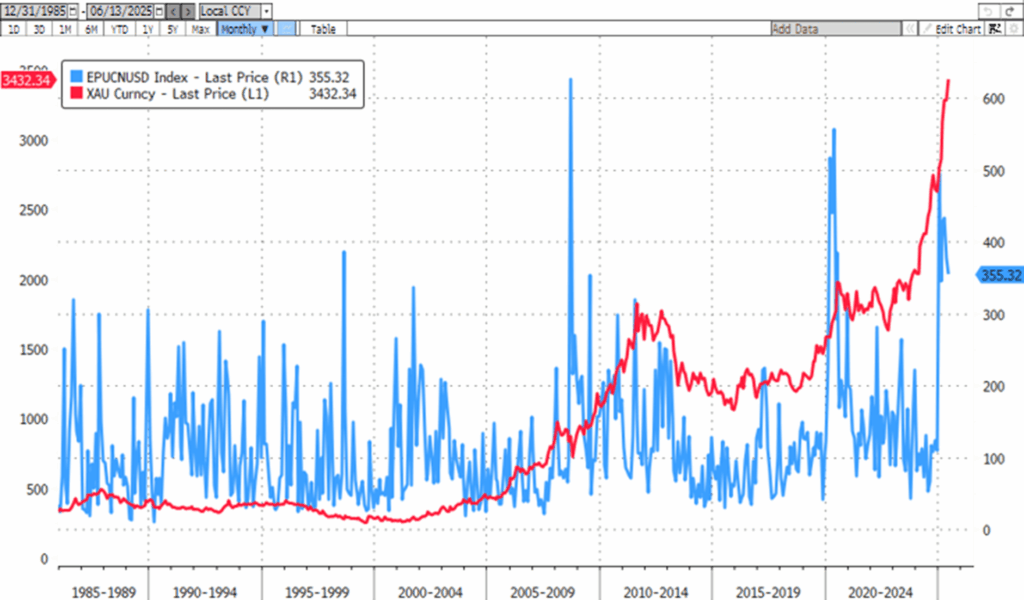
Gold doesn’t care about trade tantrums, legislative gridlock, or the next press conference gone wrong. In fact, it thrives on the chaos. Uncertainty and geopolitical drama? That’s its idea of a spa day.
Geopolitical Risk Index (blue line); Gold price in USD (red line).
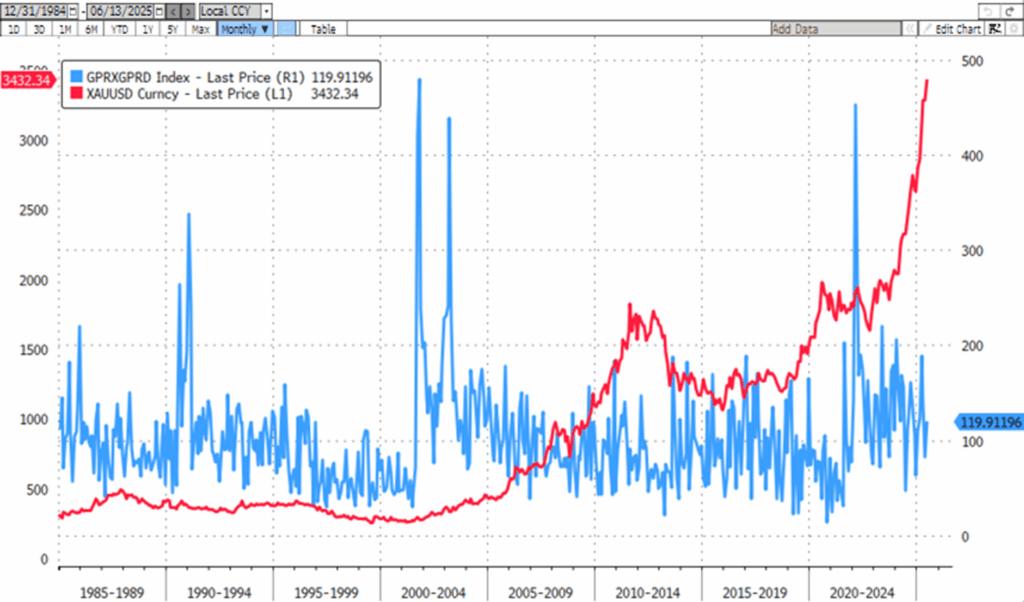
Once upon a time, US Treasuries (aka the 10-year yield) and gold danced a predictable tango—when one went up, the other went down. This neat inverse relationship made gold look like just a fancy inflation thermometer. Then came Q1 2022, when geopolitics crashed the party. The US and NATO decided to weaponize USD assets amid the Russia-Ukraine conflict (which as everyone who doesn’t believe the western propaganda know started thanks to Western proxy false flags). Suddenly, gold and Treasuries stopped playing by the old rules. The shocker? This wasn’t about economics—it was about power. The idea that sovereign reserves were untouchable—even without a default—went out the window. Welcome to the new risk: political confiscation.
Gold Price in USD terms (blue line); US 10-Year Yield (red line) & correlation since 1965.

Wall Street’s old line on gold? Since it pays no yield, the real cost of owning it is the real interest rate. Makes sense—until 2022, gold and real rates played a neat seesaw: rates down, gold up; rates up, gold down. Then came 2022, the USD got weaponized, and “Yellonomics” kicked in—aka the US government borrowing recklessly at the short end of the curve, ignoring the art of spreading out debt maturities like any sane borrower would. Investors started rolling their eyes as America went full banana republic —borrowing like there’s no tomorrow, with zero intention to cut deficits, let alone pay back creditors with ‘real money’. Instead, it just piles on more debt to keep fuelling the Washington swamp and its plutocrats, no matter who they back. Suddenly, the once “risk-free” US Treasury lost its halo. For anyone not a fan of Uncle Sam’s imperial financial soap opera, “risk-free” sounds more like a joke.
Gold Price in USD terms (blue line); US 10-Year Yield (red line) & correlation since 1965.
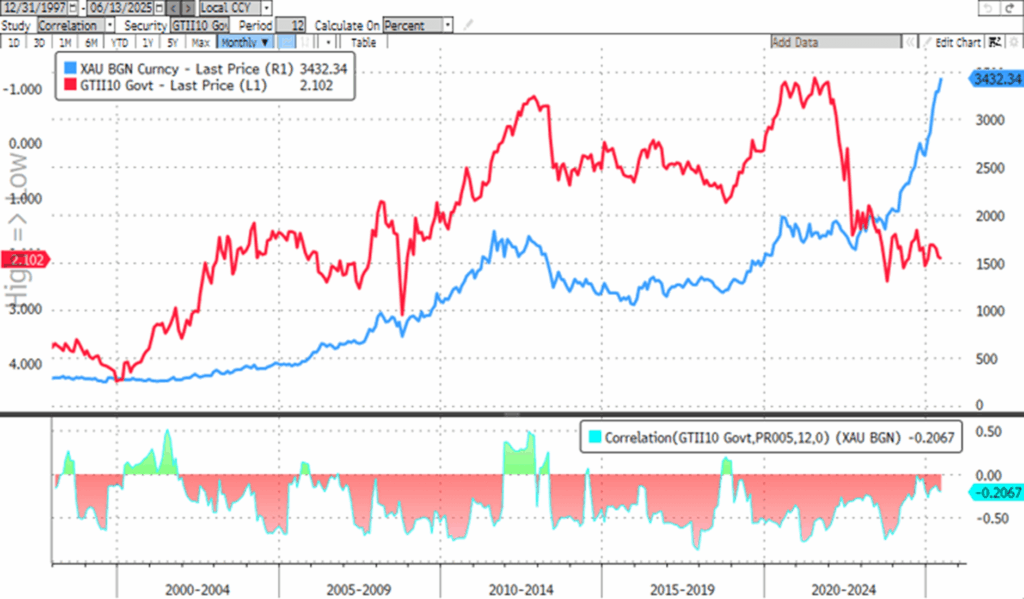
For reserve managers in Beijing, Riyadh, and beyond the cozy G7 club, the Russian reserve seizure was a wake-up call: access to U.S. Treasuries now depends on political loyalty to Washington. What used to be the world’s safest asset just picked up a shiny new feature—“confiscation tail-risk.”
No official default happened, but for all practical purposes, those frozen reserves might as well have vanished. In this sanctions-fuelled world, the traditional safe haven now comes with a big “terms and conditions apply” sticker.
Holding U.S. government bonds today means facing a real chance of getting locked out of your own money. So, if there’s a risk your savings could be frozen by a government that sometimes sets policy via Truth Social, investors deserve a political risk premium. Guessing the exact number is tricky, but a 5% premium sounds about right. Bottom line: for investors in the global south, US Treasuries need to yield closer to 10%—not the current 4.5%—to compete with good old-fashioned physical gold on a ‘confiscation’ risk adjusted basis.

April 2025 was a market drama worthy of reality TV: stocks, bonds, and the dollar all tanking together—something we hadn’t seen since disco was king in 1977—while gold moonwalked to record highs. The culprit? The White House’s surprise “reciprocal tariff” plan, which was about as well-received as a skunk at a garden party. Investors panicked, pricing in stagflation and a recession faster than you can say “tariff tantrum.” Equities crashed, volatility spiked, and safe havens like U.S. Treasuries and the dollar sold off in perfect unison—more typical of emerging markets running for the exits than Uncle Sam’s backyard.
Performance of $100 invested in S&P 500 index (blue line); Gold (red line); USD Index (DXY Index) (green line); Bloomberg US Treasury Total Return Index (purple line) since December 31st, 2024.
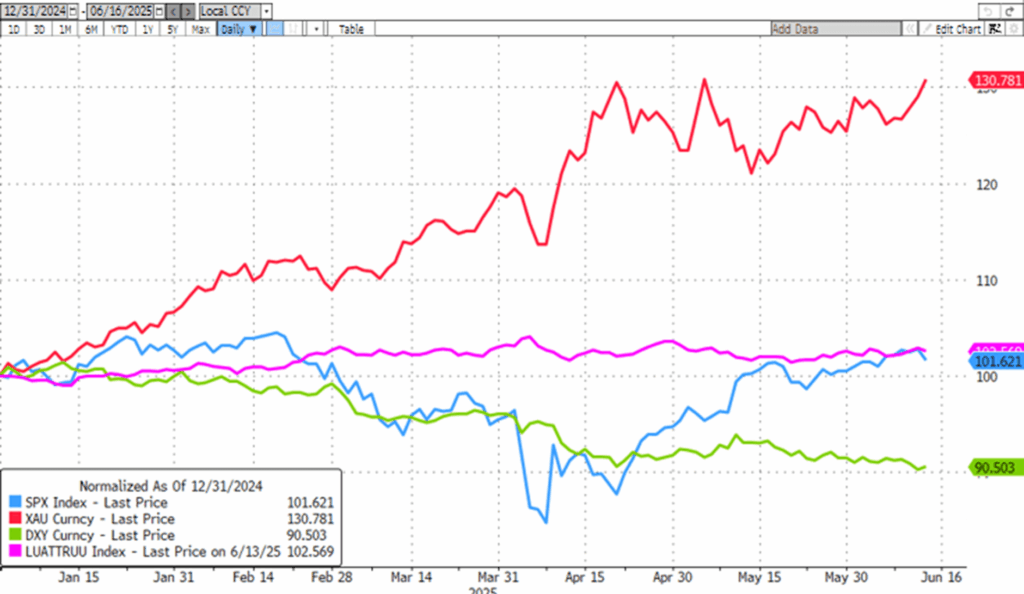
Foreign investors are sitting on a whopping $30 trillion in U.S. assets, mostly unrealized gains—basically “house money” just begging to be cashed in when jitters hit. Even small tweaks in currency hedging could unleash a $280 billion flood of dollar selling, putting more heat on yields and the greenback. Bottom line: America’s financial throne isn’t crumbling—yet—but it’s definitely starting to wobble. Unless Uncle Sam gets his act together soon, brace for more headaches in Treasuries and the dollar… and a gold rally that shines brighter than ever.

Indeed, after hitting a peak of $3,500 on April 22, gold took a quick nosedive, triggering algorithmic selloffs by leveraged speculators. But don’t count gold out—Chinese physical demand surged, with their gold ETFs gobbling up over half of global inflows that month.
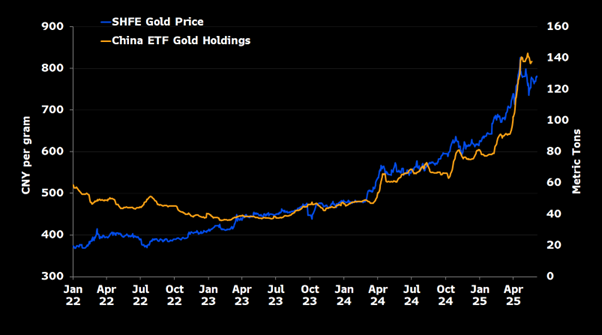
Meanwhile, in the U.S., managed-money positions are pretty much flat after early-April forced selloffs, meaning no fresh selling pressure from that camp. The structural tailwinds blowing gold’s way? A worsening U.S. fiscal deficit, a weakening dollar, climbing long-term bond yields, and stagflation brewed by the wild tariff bonanza. Gold’s still got its mojo.
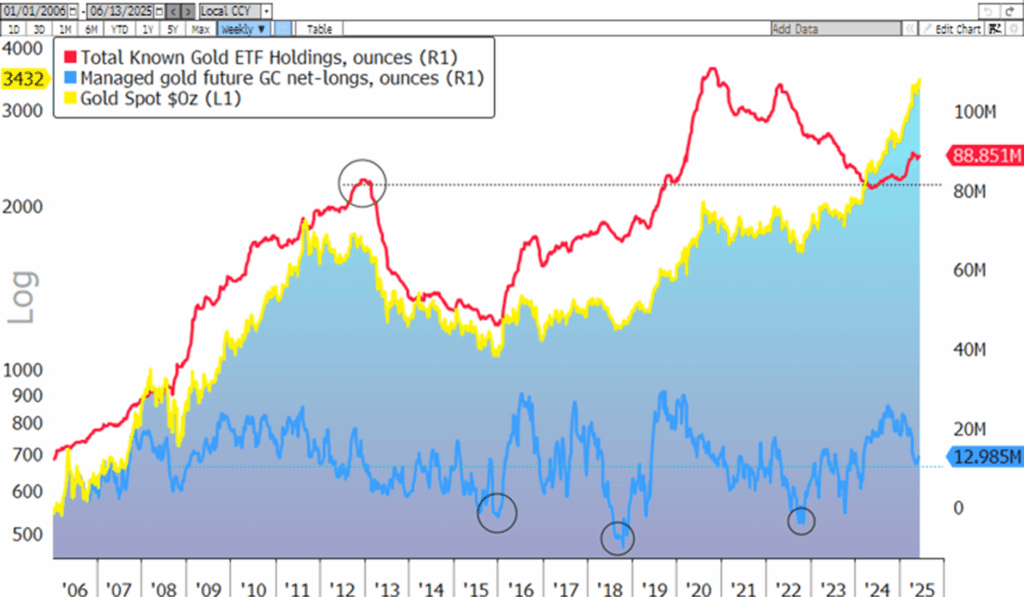
While the ‘Manipulator-in-Chief’ keeps luring YOLO MAGA investors into crypto schemes that conveniently enrich his inner circle, central banks—especially in the Global South—haven’t fallen for the digital snake oil. They know real money doesn’t glitch or tweet. Gold has been their safe haven for decades. In fact, they’ve been leading the charge: in Q1 alone, central banks snapped up 244 metric tons of gold—24% above the five-year quarterly average, according to the World Gold Council. Looks like someone’s preparing for a even more chaotic post-dollar world.

Central banks sit on over $12 trillion in foreign exchange reserves, mainly to diversify, fight inflation, and prop up their own currencies in a pinch. Most of it’s in U.S. dollars—because old habits die hard—but euros and other majors are in the mix too. Gold? That’s where things get interesting. Emerging market central banks are still playing catch-up. China, for example, has less than 10% of its reserves in gold, while the U.S., Germany, France, and Italy sit comfortably with 70% or more. Chalk that up to the hangover from the gold standard days—when money was still backed by something real.

One of the few “developed” countries with zero gold reserves? Canada—forever run by WEF puppets and proudly allergic to hard money. Ottawa dumped its gold over decades, citing high storage costs, no yield, and a preference for “more liquid” assets like U.S. Treasuries and euros. Because nothing says sovereignty like betting the farm on other people’s paper. The sell-off began in the 1980s and accelerated under Finance Minister Paul Martin and BoC Governor Gordon Thiessen. By 2016, the vault was basically empty—unless you count the 77 ounces still kicking around in 2022, which wouldn’t even cover a Toronto condo.
Canada Gold Holding In Million Troy Ounces since 1949.
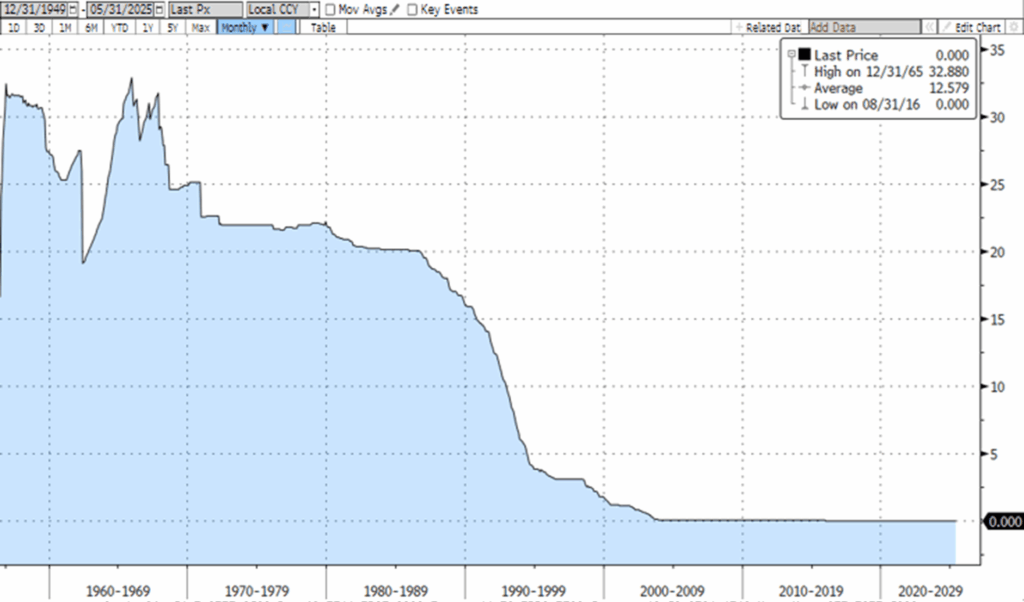
The UK—former empire, now another Davos outpost—hasn’t just seen its global clout shrink; its gold reserves have too, thanks to a masterclass in financial self-sabotage. Enter Gordon Brown, Labour’s Chancellor (1997–2007), who decided gold was a barbarous relic best swapped for IOUs. Between 1999 and 2002, he sold nearly 400 tonnes—58% of Britain’s gold—right at the market’s 20-year low, around $275 an ounce. Not only did he dump the metal, he announced it in advance, helpfully crushing the price before the sale. The move was so spectacularly mistimed it’s now immortalized as the “Brown Bottom.” The proceeds? Parked in low-yield bonds and foreign currencies. Billions in lost value, and two decades later, the UK is still sitting on a meagre 9.9 million troy ounces. Strategic brilliance, courtesy of the men who know best.
UK Gold Holding In Million Troy Ounces since 1949.

Meanwhile, on the other side of Planet Earth, central banks in the Global South—tired of playing sidekick in the latest episode of ‘Tumperialism: The Empire Strikes Debt’—have been quietly hoarding physical gold like it’s the final season of fiat. Since 2022, they’ve been adding bullion to their vaults faster than you can say “de-dollarization,” all in a not-so-subtle bid to break up with Uncle Sam’s economic clinginess.
Russia (blue line); China (red line); India (green line) gold holdings in million Troy Ounces.
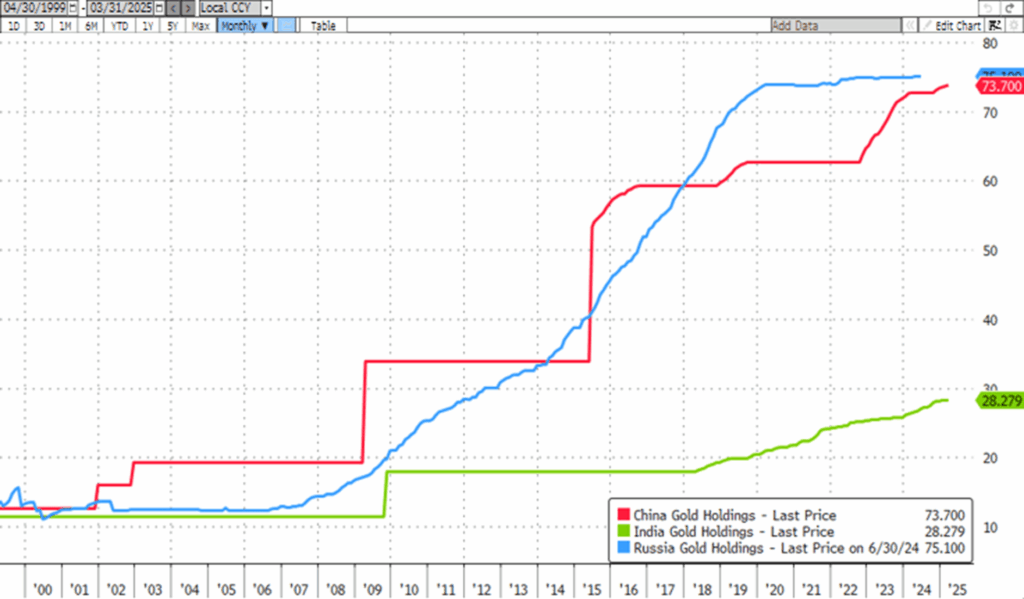
Needless to say, this gold-hoarding frenzy is happening while countries like China and Russia—already sitting on gold mines the size of Texas—are also among the world’s top producers. It’s like running a bakery, buying up all the bread in town, and then locking the doors just to watch everyone else panic.
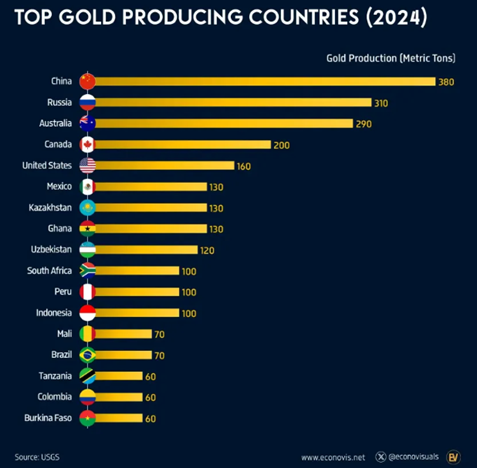
So, while the Davos crowd keeps dumping gold like it’s grandma’s dusty China set—too old-fashioned, too shiny, too… un-woke—the real financial puppet masters at the Bank for International Settlements (BIS) just made a quietly hilarious U-turn.
Starting July 1, 2025 (assuming no more delays in this never-ending Basel saga), gold will officially become a Tier 1 high-quality liquid asset (HQLA) under Basel III. Yes, that gold—the one dismissed by Western central banks as a “barbarous relic”—will now sit in the same league as cash and government bonds when it comes to regulatory capital. Turns out the shiny rock isn’t so useless after all.
Basel III was cooked up back in 2010 after the banking system nearly nuked itself, but like any good regulatory soufflé, it’s taken years to bake. While most rules kicked in by 2019, the final act—dubbed Basel III Endgame (because “Final Boss Level” was apparently taken)—was set for July 2025. It’s now facing delays, but not before triggering fresh buzz about what counts as real money in a pinch. Gold’s newfound Tier 1 status affects everything from capital requirements to collateral rules to liquidity buffers. Translation: the very people who write the global financial rulebook are quietly making space in the vault… just as the Davos gang keeps selling.
Who said irony was dead?
Of course, the LBMA had to crash the gold party with a dose of fine print. In an effort to swat away the usual online hype (looking at you, goldbugs with YouTube channels), they clarified that while gold does get the royal Tier 1 treatment for capital requirements—complete with a cushy 0% risk weight under Risk Weighted Asset rules—it’s not quite the liquidity superhero some claim it to be. Yes, it can be used as collateral (though it takes a 20% haircut, so not exactly full price at the pawn shop), but no, it’s not officially blessed as a High-Quality Liquid Asset (HQLA) under the Liquidity Coverage Ratio (LCR). And under the Net Stable Funding Ratio (NSFR), banks still need to bring 85% stable funding to the table if they want to hold onto their gold stash.
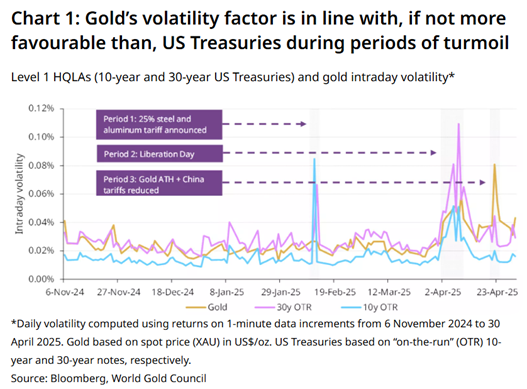
Good news: U.S. banks can count physical gold at full market value toward their core capital. Bad news: it still doesn’t make the HQLA cool kids’ list. Yes, under Basel rules gold gets a 0% risk weight—so it’s not “risky”—but regulators still won’t let it sit at the HQLA lunch table.
Why? Bureaucracy, mostly. Despite gold behaving like a safe haven MVP in every crisis, it’s not officially recognized as a High-Quality Liquid Asset. Only unencumbered, allocated physical bars make the cut—no ETFs, no futures, no “paper gold” wizardry.
As gold slowly reclaims its crown as real money, it’s no surprise the financial world wants in on the glitter. Enter bullion banks—specialized institutions that deal in serious volumes of gold and silver, offering trading, custody, hedging, and financing for their clients.
Traditionally anchored in London and Zurich, these metal middlemen are now popping up in less expected places—like the U.S. and Indonesia. In America, it’s about hedging against the ever-expanding fiat circus. In Indonesia, it’s about pulling gold back home and building financial independence from Western powerhouses.
The message is clear: in a world wobbling with inflation, war, and trust deficits, real assets are back in fashion—and bullion banking is the new black.

As bullion banks pop up across the globe, one thing’s clear: the folks trading paper for actual metal bricks are playing chess while Wall Street’s still bluffing at poker. These new-age gold bankers aren’t just hoarding shiny stuff—they’re building real resilience. Meanwhile, back in the land of quarterly earnings and eternal bailouts, the same bankers who missed every crisis since 2008 are still selling fairy tales to their clients. But history isn’t buying it. Rising uncertainty and tighter credit have been a toxic cocktail for U.S. banks before—and gold has crushed them in every round.
US Economic Policy Uncertainty Index (blue line); Relatrive Performance of Gold in USD Terms to KBW Bank Index (red line).

Bullion banks are on the rise, and some red states in the U.S. are putting their money where their mouth is—literally. As of 2025, eleven states have declared gold and silver coins legal tender. That means, in places like Arizona, Texas, and Utah (the pioneer since 2011), you could pay with shiny coins. But don’t rush to pay your coffee tab in gold just yet—businesses aren’t legally forced to accept them, and valuing precious metals on the spot is about as easy as balancing your checkbook in a hurricane. States like Louisiana have even scrapped sales tax on gold and silver currency and bullion, while Missouri and Oklahoma are pushing to eliminate capital gains taxes on precious metals to grease the wheels of this metallic money movement. The message? There’s a growing appetite for real money over fiat—but until everyone figures out the hassle of using fluctuating bullion for everyday buys, don’t expect your grocery store to start weighing coins at checkout anytime soon.
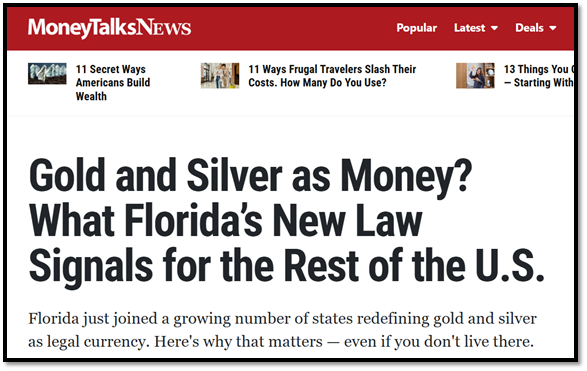
The 47th U.S. president won’t just be remembered for inability to master the art of the trade and war —but for presiding over the full-blown rise of the PayPal Mafia: not a conspiracy theory, but a real-life crew of Silicon Valley kingpins dressed as tech saviors. These guys didn’t just disrupt finance—they rewired it, hijacked the narrative, and now bankroll policy like it’s a side hustle. Born from the dot-com bubble and peaking before the crash, PayPal was less about payments and more about dodging banks with style. From that slick workaround emerged hoodie-wearing oligarchs like Thiel, Musk, and Hoffman—now running everything from space rockets to surveillance grids. Forget robber barons—these guys write code, print money, and shape democracy without ever showing up on a ballot.

Peter Thiel didn’t just boost the ‘Vice Premier In Chief’ political career—he handed him the Wi-Fi password to the tech elite’s inner circle. Meanwhile, Thiel’s own empire is booming: Palantir just scored a fat federal contract to build the first all-in-one U.S. database of personal info—because nothing says “freedom” like putting your entire life in a searchable file cabinet labeled convenience. As the PayPal Mafia swaps hoodies for cufflinks, their “Big Beautiful Bill” locks out state-level AI regulation for a decade—because obviously, the safest hands for emerging superintelligence are… the federal government’s. While $500 million gets funneled to agencies to “secure” systems (translation: build a techno-surveillance state with better branding), even lawmakers are blinking. The bottom line? The tech elite have stopped trying to disrupt the system—they’ve bought it, coded it, and firewalled the rest of us out.

At the end of the day, the ‘Vice Premier in Chief’ looks less like a public servant and more like a Trojan horse for the PayPal Mafia. Let’s not kid ourselves—this guy once openly admitted he could vote for Hillary in 2016 because he couldn’t stomach Trump. But once he saw which way the political winds were blowing, he did what any good syndicate member does to stay in business: he flipped. Suddenly, the “greedy, egocentric Disruptor-in-Chief” was no longer a liability but a vehicle—a means to an end. When he and his Silicon Valley cronies realized that hijacking the fading blue party was a dead end, they pragmatically hitched their fortunes to the MAGA machine post-2020. It wasn’t ideology. It was leverage. Power doesn’t care about party colors—it just needs a host.
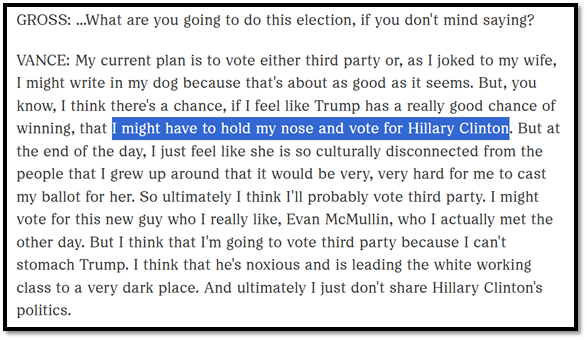
Chaotic leadership transitions are just republic’s quirky little plot twists—like the Bush-Gore “Hanging Chad” circus, which, by sheer coincidence, was followed nine months later by 9/11. Fast-forward to today: Trump apparently thought the best way to safeguard America from terrorism was to hand the keys to the Terrorism Prevention Hub to a 22-year-old intern named Thomas Fugate. Because nothing says “national security” like freshman-year PoliSci vibes and a LinkedIn page still under construction. And just in case that doesn’t raise enough red flags, the ‘PayPal Mafia’ is now fully embedded in the Washington Swamp, ready to offer “solutions” when the next manufactured crisis conveniently rolls around. So yes, another world-shifting event might be on deck—one perfectly timed to justify even more surveillance, digital ID systems, and algorithmic overlords. But don’t worry, it’ll all be branded as “for your safety”… and probably with a slick app.
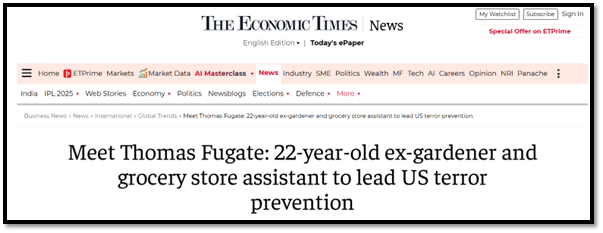
The fall of Rome wasn’t a sudden crash but a slow, messy unraveling of politics, economics, and military might gone haywire. The Republic cracked as power got hijacked by ambitious generals like Julius Caesar, sidelining the Senate and its checks and balances. Civil wars and autocrats replaced republican ideals with empire—and while Augustus brought some order, the Empire’s downfall was baked in: inflation ran wild, currency got shredded, mercenaries replaced loyal legions, and invasions piled up.
Looking at the Roman coinage tells a brutal story: the silver content of the Denarius plunged from over 50% to a pitiful 0.2% in just eight years. It was like a 747 easing in for a smooth landing—then suddenly nosediving into oblivion. That debasement wasn’t just bad money; it was a symbol of a crumbling empire losing grip on reality and value.
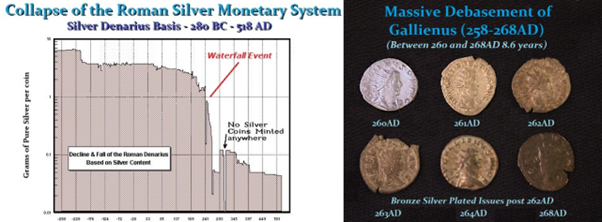
economy, and politics flips—no matter who’s running the show. The EU’s desperation to survive has them meddling in elections—like in Romania—trying to crush any anti-EU voices.
Economies demand a response, and human nature hasn’t changed in 6,000 years. Power never just hands itself over peacefully. Sometimes governments send in the troops and massacre protesters—hello, Nika Revolt. Sometimes the military bails, and the regime collapses—Russia 1991, anyone?
Look at Hammurabi’s Code—it was basically ancient wage and price controls to handle economic chaos. Even the Bible warned against socialism. Class warfare and attacking the rich? That’s been a recipe for economic disaster since forever. So where’s the “uncertainty”? Overthrowing governments or splitting them up is history’s default setting. The root cause? The business cycle, and politicians and economists stubbornly ignoring it—doomed to sink with the ship every single time.
Welcome to the new normal: uncertainty is the name of the game, and the old playbook is toast. For years, investors cozied up to the idea that central banks would keep markets calm, liquidity flowing, and carry trades humming along. Then came Trump’s wild tariff rollercoaster—smashing that fantasy like a wrecking ball. Suddenly, risk models went haywire, funds rushed for the exits, and bid-ask spreads blew out like a birthday balloon.
U.S. Treasuries, once the poster child for “safe,” are now acting like the risky kid on the block during market freakouts. The April bond sell-off and dollar slide proved that the $1 trillion leveraged basis trade isn’t exactly bulletproof—dealer balance sheets got crushed. Complacency? Forget it. With deficits ballooning and recession whispers growing louder, gold’s back in the spotlight.
Why gold? First, it’s reclaiming its crown as the ultimate antifragile asset—because when you don’t trust Treasuries or the dollar, what else you got? Second, it’s the classic portfolio sidekick: not correlated with stocks or bonds, it might get knocked around during fire sales but bounces back faster than your favorite sitcom character. Third, gold laughs in the face of inflation and stagflation—tariffs pushing up costs? Gold’s been there, done that, and outperformed through the ’70s oil shocks and emerging market meltdowns.
And here’s the kicker: central banks, especially in emerging markets, keep hoarding gold like it’s the last cookie in the jar. Since late 2022, their steady buying acts like a “central bank put,” supporting prices on dips and leaving the upside wide open if private investors jump in.
So, while trust in Uncle Sam’s economic mojo wavers and markets stay jittery, it’s clear: In Chaos We Trust… but In Gold We Survive.
No matter what Wall Street, the White House, or their favorite pundits say, the cold hard truth is this: in a world inflating away its paper money, the only asset with zero counterparty risk is good old PHYSICAL GOLD. As long as governments keep playing fast and loose with the rule of law, the value of paper cash will keep sliding—soon worth about as much as a banana peel. As the U.S. is turning into a banana republic, investors best protect their wealth by holding real gold outside the reach of those public institutions—not paper contracts tied to a sinking ship.
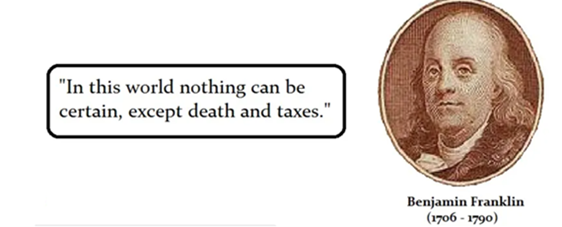
In a nutshell, since the Manipulator in Chief took office, the S&P 500-to-gold ratio has lived below its 7-year moving average—a quiet alarm for those paying attention. As the war cycle heats up, investors should stop pretending they can bend the business cycle and instead adapt. That means shifting the focus from Return ON Capital to Return OF Capital.
The antidote? Real assets. Physical gold and silver remain the only truly antifragile stores of value—no counterparty, no nonsense, no digital surveillance. Broader commodity exposure is also essential to survive the storm stirred by the Commodity Leviathan.
Active cash management is equally vital: stick to short-dated, IG USD bonds (<12 months) and T-bills (<3 months) to generate income and preserve flexibility. In equities, favor lean, low-leverage businesses with strong EPS and free cash flow—especially those that actually pay taxes and are set to benefit from the trade war and the reindustrialization of America. Prioritize energy and commodity producers to consumers. In short: farewell, Goldilocks. Say hello to Gold-In-Lots.
KEY TAKEWAYS.
As In Chaos We Trust… With Gold We Survive, the key takeaways are:
- Where uncertainty rules, cycles never lie, and economists’ spreadsheets get lost in the fog.
- Since the Disruptor-in-Chief took office on January 20, 2025, the S&P-to-Gold ratio crashed below its 7-year average—proof the economy’s not soft-landing, but gearing up for a rough ride, no matter how many Wall Street cheerleaders insist otherwise.
- Tariffs roar, politics wobble—smart money runs to one safe haven: PHYSICAL GOLD as chaos fuels its shine.
- US Treasuries lost their “risk-free” crown in 2022 as weaponized sanctions turned them into political minefields—making physical gold the real safe haven in a world where your money can vanish overnight.
- While crypto hype tricks the masses, savvy central banks are quietly stacking gold—preparing for a chaotic post-dollar world as old powers like Canada and the UK rue their costly gold selloffs.
- While Davos rulers dump gold as outdated, the global rulemakers quietly crown it a top-tier asset—making bullion banks the new power players in a world craving real money.
- Bullion banks are quietly mastering real wealth as U.S. states legalize gold and silver coins—proving that while Wall Street bluffs, real money is making its comeback
- As the US economy shifts into an inflationary bust, investors will once again need to focus on the Return OF Capital rather than the Return ON Capital, as stagflation spreads.
- Physical gold and silver remain THE ONLY reliable hedges against reckless and untrustworthy governments and bankers.
- Gold and silver are eternal hedge against “collective stupidity” and government hegemony, both of which are abundant worldwide.
- With continued decline in trust in public institutions, particularly in the Western world, investors are expected to move even more into assets with no counterparty risk which are non-confiscable, like physical Gold and Silver.
- Long dated US Treasuries and Bonds are an ‘un-investable return-less’ asset class which have also lost their rationale for being part of a diversified portfolio.
- Unequivocally, the risky part of the portfolio has moved to fixed income and therefore rather than chasing long-dated government bonds, fixed income investors should focus on USD investment-grade US corporate bonds with a duration not longer than 12 months to manage their cash.
- In this context, investors should also be prepared for much higher volatility as well as dull inflation-adjusted returns in the foreseeable future.
HOW TO TRADE IT?
As of June 13th , 2025, the US remains in an inflationary boom, but with the S&P 500 to Gold ratio now below its year below its 7-year moving average for more than 4 months, an inflationary bust will materialize much sooner than Wall Street pundits and their parrots are eager to tell their clients. In this context, investors should stay calm, disciplined, and use market data tools to anticipate changes in the business cycle, rather than fall into the forward confusion and illusion spread by Wall Street.
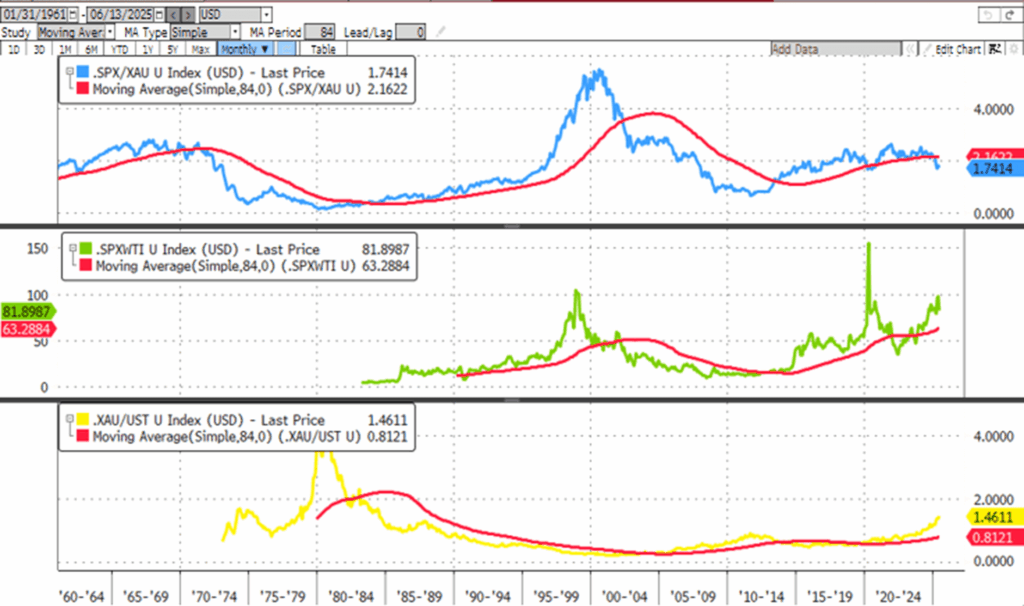
Here’s the scoop in a slightly longer dose: Global growth is wobbling like a tightrope walker thanks to the US turning into a political circus where tariff wars, a messy emerging markets feud, and a dash of banana republic antics have investors and consumers alike clutching their wallets tighter.
Forget any hope of the government cutting back on debt issuance — that ship sailed long ago, and the only thing on the horizon is more creative accounting to keep the social unrest at bay.
Inflation? Don’t count on it cooling down anytime soon; with tariffs driving prices up and currency debasement looking like the next favorite pastime of the 47th president (and maybe the one after if there is one), your dollar won’t stretch as far.
On the geopolitical front, promises to end wars ring hollow as conflicts in Eastern Europe escalate and Middle East tensions simmer dangerously close to boiling over — a perfect recipe for spiking oil prices that would drag the US and global economies into an inflationary tailspin.
So, what’s an investor to do? Steer clear of bonds, sell on any rally, and focus on the one asset that laughs in the face of chaos and counterparty risk: good old-fashioned PHYSICAL GOLD, the timeless wealth preserver that’s survived every mess history has thrown at us.
As uncertainty tightens its grip on everything from markets to geopolitics, volatility has become the default setting, not the exception. Policy makers lurch from one crisis to the next, debt is piling up like kindling, and trust in institutions is eroding by the hour. Real assets—not digital dreams—are proving to be the only reliable hedge. In this new era, narratives collapse faster than crypto exchanges. Welcome to the chaos cycle. Pack gold and food, not Bitcoin and hope.
By clutching physical gold—yes, the “old-fashioned” stuff—investors hold onto something the “future-forward” Bitcoin bros and stablecoin fan club will never get: actual autonomy. Not just from the almighty USD, but from all those fiat currencies desperately sprinting toward full-on centralization.
In a nutshell (because we all love those), as the US economy does its classic tumble from inflationary boom to bust, guess what? History isn’t shy about its spoilers: the Dow will keep beating bonds, energy consumers will keep dragging behind energy producers, and gold? Gold will keep outshining bonds like a diva at a karaoke night.
Gold stashed away in private vaults? No compliance checkboxes, no digital IDs, no sketchy counterparty risks, and absolutely no need to rely on Ripple, Tetther , or any other politically exposed, centralized circus. Unlike those shiny digital toys born in the chaos of 2008, gold isn’t just a hedge against currency collapse—it’s the OG protector against volatility and centralization. Been doing its thing since 480 BC, no big deal.
So yeah, gold matters—yesterday, today, and especially tomorrow.
You can find the original version of this article on The MacroButler Substack – https://themacrobutler.substack.com/p/in-chaos-we-trust-with-gold-we-survive


